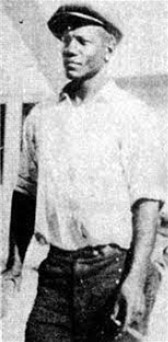Originally published to Facebook.com/NorthPlattePL on February 5, 2021.
Friday History Series: The Fastest Brick-Layer in Nebraska
Arthur Hurd was born in either 1887 or 1888, there is no birth certificate for him and various resources show different birth years.
Hurd seems to of had a rough life after leaving home as his name starts showing up in the “Crime Scene” articles in the Lincoln, Nebraska newspapers. From 1904 up through 1916 Hurd was arrested many time for various charges, such as throwing brick at a policeman, highway robbery, purse snatching, riding without paid passage on trains, and operating a disorderly house.
Hurd was married in 1914 to Lulu Scott of Lincoln. The marriage came to an end when a large fight occurred between the Hurd family and Lulu, according to the Nebraska State Journal on March 2, 1916. Officers were called and both Arthur and Lulu were charged with disorderly conduct. Lulu promised to go back to Kansas to her family and leave the marriage if the charges would be dropped. Arthur agreed and was glad to have his “freedom” back.
Hurd started brick-laying sometime in 1913. The Lincoln Journal Star printed this short article on October 1, 1913: “For two men to lay 72,400 paving brick in ten hours is a considerable feat. The average day’s work of that kind is 25,000 a day. Arthur Hurd of Lincoln and William Wright (both from Omaha) laid 72,400 paving brick in David City Tuesday. They are in the employ of Contractor I. E. Doty, who has the contract for nineteen blocks of street paving in David City. Superintendent Bell, in charge of the street paving work, says Hurd and Wright are faster in their line than any other men he has known of.”
On February 9, 1918 Hurd passed his physical examination and was qualified to serve during World War I. A detachment from Lincoln, Nebraska left for Camp Pike, Arkansas in August 1918 for training. Arthur shipped out of New York City on October 12, 1918 and he was assigned to Company “H” 816th Pioneer Infantry. The Pioneer Infantry units were primarily African American men trained to be engineers. They did receive combat training but most of their time was spent constructing roads and bridges. After the end of the war they were assigned the sobering task of collecting bodies and body parts from the battlefields of France and prepare them for burial according to historian Kristin Spalding.
In 1920, Census records show Arthur living with his sister Malinda’s family in Lincoln, Nebraska. The record shows his occupation as a brick-layer. On November 5, 1921 Hurd married Dollie Duncan in Council Bluffs, Iowa. Shortly after their marriage they came to North Platte. Arthur was working for the Able and Roberts-Asphalt and Brick Paving Company.
Dollie was interviewed in 1973 by historian John McNeil and she talked about how proud Arthur was for being the fastest brick-layer in the state of Nebraska. She said he was a “well-built man with muscular arms and shoulders.” She said he would only eat toast and a small bowl of cereal for breakfast and a sandwich for lunch with a boiled egg because you didn’t lay bricks on a full stomach.
According to McNeil, “Hurd would lay five rows of brick, then a relief man would lay one row while Arthur rested his knees and back.” “Ten men, five on each side, carried the bricks and piled them on either side of Hurd,” said Dollie.
Hurd continued laying bricks through the warm months up through 1928. During the winter months he would find other jobs. In April of 1928, Hurd had been working in the Higgins Chevrolet Garage when a car fell off of a hoist and crushed him. He passed away shortly after and was taken to Wyuka Cemetery in Lincoln for burial.
The brick portions in downtown North Platte still have the original 1921 bricks that Arthur Hurd and others laid. They provide beautiful nostalgia to the newly created “Canteen District” in downtown North Platte.
The picture was from the May 23, 1973 article in the North Platte Telegraph.
